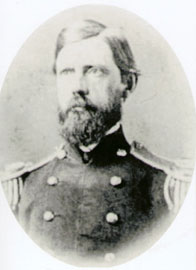 |
|
Quick Facts |
-
Born: September 21, 1820
-
Died: July 1, 1863
-
Parents: John & Lydia Moore Reynolds
-
The fourth of nine childen.
-
Great, great, great grandson of Madame Ferree. A descendant of the Ferree family through the Daniel & Anna Maria Leininger family and also the Catherine Ferree and Isaac LeFevre family.
-
Never married.
-
Was known as a brilliant soldier and one of the most highly esteemed Union Army commanders.
|
|
Pre-Civil War Military Career
John Fulton Reynolds graduated from the U.S. Military Academy at West Point in 1841. He served with the army throughout the Mexican War where he received the brevet rank of Major for meritorious service. After the war, he was stationed in the New England area, New Orleans, and other different places and went with an expedition across the country to Salt Lake City and then to California where he was engaged in expeditions against the Indians. He returned to Utah with his regiment several years later for military duties. In September 1860, John Fulton was appointed Commander of Cadets at West Point and in May, 1861, was promoted to Lt. Col. and recruited his regiment to full strength for service in the Civil War.
Civil War Service
In August of 1861, he was promoted to Brigadier General and commanded Fort Hatteras. Pennsylvania Governor Curtin requested that he be assigned to the Pennsylvania Reserve Corps. This was done and he fought with his brigade on the peninsula of Virginia in General Pope's campaign. His command was engaged at Gaines' Mill. Following the close of action that day Reynolds fell asleep after being cut off from his troops and was captured the next morning. He was interred at Libby Prison in Richmond, but was exchanged on August 13, 1862, in time to command the Pennsylvania Reserves in the defeat at 2nd Bull Run. Again, at the Governor's request, he returned to Harrisburg to command the new Reserve Corps of 75,000 state militia. He organized and marched them up the Cumberland Valley to protect the southern borders of the state because of the anticipated invasion of Maryland and possibly Pennsylvania by the Confederates. After the Battle of Antietam in Maryland, the militia disbanded and General Reynolds rejoined the Army of the Potomac and assumed command of the 1st Corps. He rendered distinguished service at the Battle of Fredericksburg, Virginia, and was at Chancellorsville, although not in action. He allegedly advised Major General Joseph Hooker to advance rather than retreat and became disgusted with Hooker's leadership.
Gettysburg and Death
John Fulton Reynolds, at this time a Major General, was considered for command of the Army of the Potomac. He declined the position and the command was given to his close friend and fellow Pennsylvanian, Major General George G. Meade. On the first day of the Battle of Gettysburg (July 1st), Meade ask Reynolds to lead the advance left wing of the army comprised of three corps, the 1st, 3rd, and 11th. This wing of the Union Army held off the Army of the Confederacy invaders for many hours but the troops were heavily outnumbered and Reynolds realized he had to reinforce their position. He became a conspicuous target as he rode forward on his horse to change the position of the artillery batteries. He was killed instantly by a sharpshooter with a single shot through the head. It is said that Confederate General Robert E. Lee, who knew Reynolds personally, expressed sorrow over his death. He was buried on July 4, 1863, in the family enclosure in Lancaster County.
Commemoration
The statues and monument below honoring Reynolds are located on the Gettysburg Battlefield. The first can be found on the Pennsylvania Monument, added in 1913. The bronze statue was erected by members of his corps in 1899. The granite monument was dedicated in 1886 by the state of Pennsylvania and marks the spot where he fell.
A member of our illustrious Ferree family, John Fulton Reynolds was an outstanding soldier, a brave officer, and a great leader eager to defend his home state and gave his life doing that.
|
